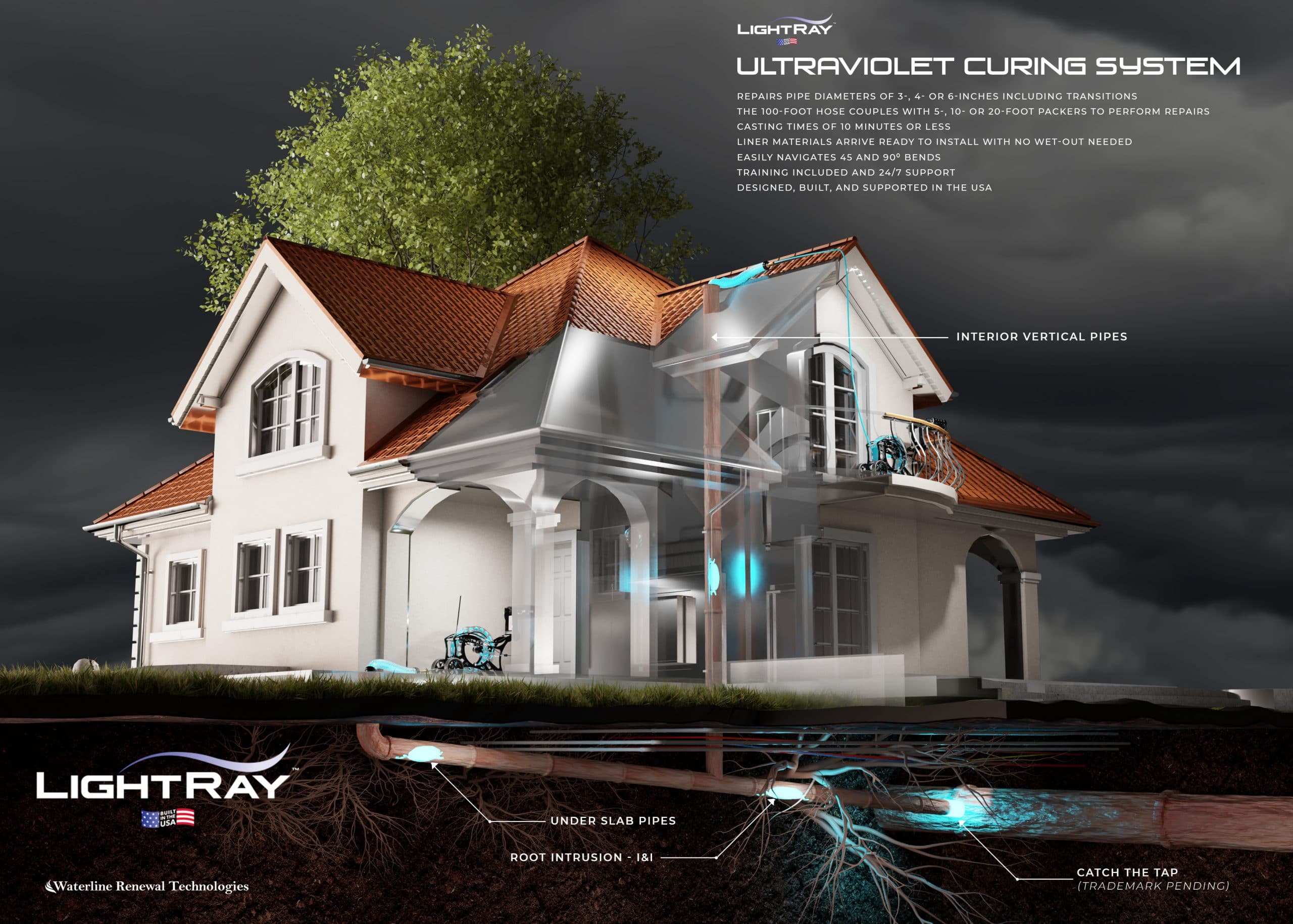
REASONS WHY YOU SHOULD START USING UV CURING WITH TRENCHLESS TECHNOLOGY
As underground sewer and infrastructure ages and deteriorates, plumbing contractors have several repair and replacement methods at their disposal for fixing them. Cured-in-place pipe (CIPP) lining is a top solution for municipal, commercial and residential applications because it requires no digging to rehabilitate broken, cracked or leaking pipes. This trenchless technology involves inserting a liner into the existing host pipe, essentially creating a new pipe within a pipe. Typically done in a day or less, the simple process eliminates costly excavation and rebuilding of infrastructure.
A more modern approach to CIPP is an adaptation of the technology that capitalizes on the advantages of using ultraviolet (UV) light to cure the liner’s resin. UV curing, and by extension, UV CIPP, significantly reduces time and resources, lowers risks and costs, and produces higher quality results than traditional thermal heat or ambient curing processes.
To begin the UV curing process for CIPP, installers create two entry points on both ends of the failing pipe. These access points are not created in most cases but rather a cleanout or manhold is used. A glass-reinforced polyester (GRP) liner, impregnated with a special UV resin, is inserted into the sewer or drain pipe. Installers can also push the liner in place for applications without two access points. Once the liner is pushed or pulled into place, a bladder is inflated with air. UV lights are then activated to cure the resin, effectively creating a new pipe via UV curing with high-strength and high-durability characteristics.
When considering whether UV trenchless technology may be the right solution for your next pipe rehabilitation project, contractors and engineers should fully understand the benefits that can be realized. These include:
Compared to traditional sewer pipe excavation methods, pipe relining via trenchless technology minimizes ground disturbances to property. Homeowners especially are never pleased to see their hard-earned investments or landscaping unearthed, even for a short time. Besides the unsightly damage and inconvenience caused by digging, bad backfill after a pipe dig can affect the grading and drainage of property and lead to structural issues down the line. Also, the exposal or cutting of tree roots during trenching can cause trees to die.
With UV trenchless technology, the entire CIPP rehabilitation process goes much faster. The ultraviolet light used in UV CIPP systems cures the circumferential GRP lining in minutes. Instead of waiting hours or days for traditional curing methods to set, installers can wrap up UV curing jobs within shorter planned schedules. No major digging means less coordination, less prep and less cleanup.
By combining advanced fiberglass materials with modern UV curing technology, the UV CIPP lining process creates a stronger, longer-lasting pipe than traditional curing methods can achieve. UV CIPP technology has been proven in thousands of installations across North America. UV cured pipe liners are designed to withstand harsh underground conditions throughout their expected 50-year lifespan.
UV curing does not require heat and trenchless technology involves little digging, so the risk of damaging existing host pipes or surrounding pipes is greatly reduced.
Trench and excavation accidents are among the most dangerous and devastating types of worksite accidents. Serious injuries can occur from falls, cave-ins, electrocutions, explosions and heavy-machinery mishaps. This modern approach significantly reduces hazards, protecting your crew members from harm and you from personal injury lawsuits.
The UV curing process is a flexible one that works for lateral and vertical pipes. Your crew can quickly go from one job site to the next with trenchless equipment that’s designed for efficiency and ease of use. The latest UV curing technologies can accommodate pipes up to 6 inches in diameter and 100 feet in length.
While CIPP relining reduces the original pipe’s inside diameter (ID), UV cured pipe liners will often increase flow capacity. This occurs because the new liner surface is much smoother than the original pipe, resembling the surface of polyvinyl chloride (PVC) pipe. The liner thickness is also relatively thin, so the ID reduction is not very significant.
Traditional water and steam CIPP installations use a lining tube made from a styrene-based thermosetting resin that has been shown to contaminate ground sites and sewer systems due to poor installation practices, uncured resin that escaped, or some degree of permeability in the lining material. Since UV CIPP lining is made from GRP (fiberglass) and cured by ultraviolet light rather than water or steam, these inherent risks and general water disposal contamination problems are eliminated. UV CIPP’s faster cure rates also result in less energy consumption spent on bypass pumping.
Southwest Florida Drain Doctors
Nobody Wows Clients Like We Do!
Give us a call today and learn all of what we can do for you.
Customer Satisfaction
Client Testimonials
Review Us
Southwest Florida Drain Doctors
About Us
Lets get in touch